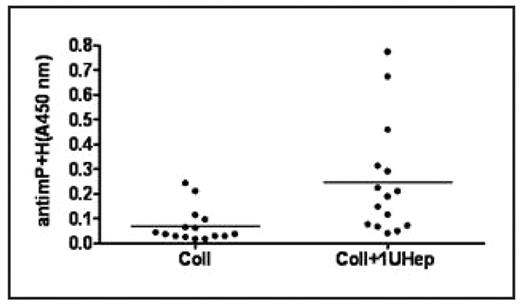Abstract
Heparin-Induced Thrombocytopenia (HIT) is an immune-mediated thrombotic disorder caused by antibodies that recognize complexes of Platelet Factor 4 (PF4) and heparin. We have previously shown that exogenous administration of murine PF4 (mPF4) and heparin (mP+H) daily for five days into mice leads to development of high titer PF4/heparin autoantibodies (anti-mP+H; Suvarna Blood, 2007). While this experimental model has been extremely useful for understanding various biological aspects of heparin sensitization, this murine model requires extremely high-doses of mP+H to elicit antibody production. To circumvent this non-physiologic approach, we studied effects of in vivo platelet activation in mice with or without concomitant heparin administration. After receiving approval from our Institutional Animal Care and Use Committee, we initially performed dose-finding studies of various platelet agonists {arachidonic acid (AA), ADP, collagen and PAR-4} to identify the maximal tolerated dose associated with in vivo platelet activation (assays of circulating PF4 levels) and associated with increased morbidity. Once optimal doses of platelet agonists were identified, we injected agonists in the presence or absence of heparin daily for five days and monitored for development of PF4/heparin antibodies as previously described (Suvarna, Blood, 2005). Of the various agonists tested, we noted development of anti-mP+H in mice injected with collagen (coll), but not in mice injected with AA, ADP and PAR-4. Moreover, anti-mP+H responses in mice injected with collagen showed heparin dependence, as shown in the Table below.
| Mean A450nm . | |
|---|---|
| Collagen (coll) alone (n=5) | 0.04 ± 0.01 |
| coll + 0.25 U/mL hep (n=5) | 0.1 ± 0.04 |
| coll + 0.5 U/mL hep (n=5) | 0.1 ± 0.02 |
| coll + 1 U/mL hep (n=5) | 0.32 ± 0.27* (P<0.05 v collagen alone) |
| Mean A450nm . | |
|---|---|
| Collagen (coll) alone (n=5) | 0.04 ± 0.01 |
| coll + 0.25 U/mL hep (n=5) | 0.1 ± 0.04 |
| coll + 0.5 U/mL hep (n=5) | 0.1 ± 0.02 |
| coll + 1 U/mL hep (n=5) | 0.32 ± 0.27* (P<0.05 v collagen alone) |
Additional cohorts injected with coll + 1U/mL heparin showed significantly higher rates of seroconversion (mean A450nm= 0.25 ± 0.06, n=15) as compared to mice injected with coll alone (mean A450nm= 0.07 ± 0.02, n=15; p=0.007 for coll+hep v. coll alone, See Figure). In mice treated with coll+ 1U/mL Hep, anti-mP+H were specific for mP+H (mean A450nm= 0.358 ± 0.133) as compared to mPF4 alone (mean A450nm= 0.06±0.007). Anti-mP+H did not recognize rat albumin (mean A450nm= 0.015 ±0.006) or ELISA wells coated with PBS (mean A450nm=0.019 ±0.003). In summary, these studies indicate that anti-mP+H can be elicited in mice after platelet activation and heparin exposure. Further refinements of this model will be important in advancing our understanding the physiologic basis of heparin sensitization.
Disclosures: No relevant conflicts of interest to declare.
Author notes
Corresponding author


This feature is available to Subscribers Only
Sign In or Create an Account Close Modal